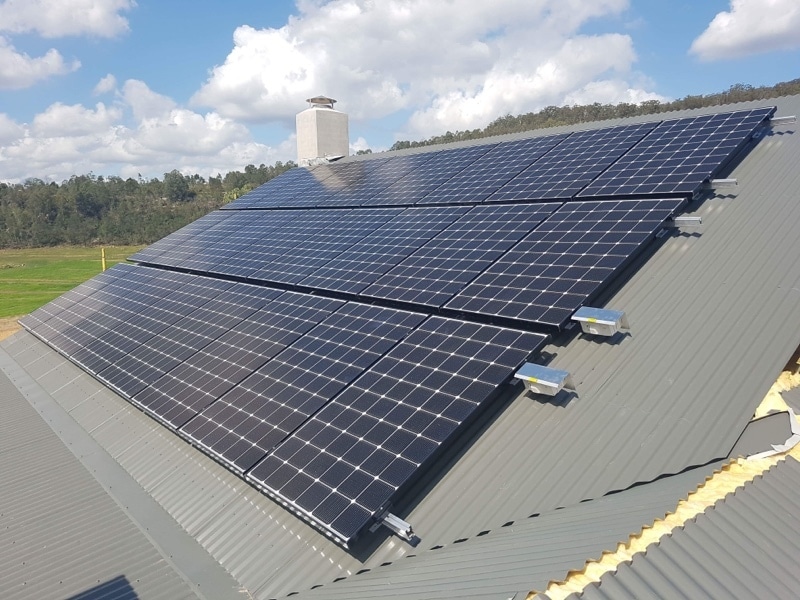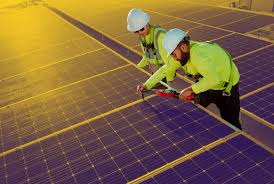5 Types Of Solar Panels Explained
Monocrystalline (22-23% eff, sleek), polycrystalline (18-20%, blue), thin-film (10-15%, flexible), PERC (boosts 1-2% eff), and perovskite (lab 25%+) vary in efficiency, aesthetics, and use—from residential roofs to portable chargers—balancing cost and performance.
Monocrystalline: High Efficiency & Cost
Monocrystalline panels typically achieve efficiency ratings between 20% and 23% for commercially available residential models, with some high-end products from brands like SunPower now exceeding 22.8%. In practical terms, this means a 400-watt monocrystalline panel will generate the same amount of power as a 340-watt polycrystalline panel in the same physical footprint, allowing you to maximize energy production on a roof with limited space. However, this top-tier performance comes at a cost, with mono panels generally being 10-20% more expensive per watt than their polycrystalline counterparts.
For a standard 60-cell residential panel, this can result in a power output ranging from 350 watts to over 400 watts. The efficiency doesn't just affect size; it also impacts performance in real-world conditions. Monocrystalline panels, particularly those with PERC (Passivated Emitter and Rear Cell) technology, which can add a 1% absolute efficiency gain, demonstrate better performance in low-light conditions, such as during early mornings, late afternoons, or on cloudy days. They also generally have a lower temperature coefficient, around -0.30% per degree Celsius, compared to -0.40% for polycrystalline.
Feature | Typical Monocrystalline Specification |
Average Efficiency Range | 20% - 23% |
Temperature Coefficient | -0.29% to -0.35% / °C |
Power Output (60-cell) | 350W - 410W |
Annual Degradation Rate | 0.3% - 0.5% |
Average Cost per Watt | 1.00−1.50 |
Lifespan | 25-40 years |
Most manufacturers guarantee that their mono panels will still produce at least 92% of their original output after 25 years, and many will still be operating at 80% efficiency after 40 years. This slow degradation rate, typically just 0.3% to 0.5% per year, ensures a strong return on investment.

Polycrystalline: The Budget-Friendly Choice
Instead of using a single silicon crystal, molten silicon is poured into a square mold and cooled, forming a block filled with multiple crystals. This method is faster and wastes less silicon, leading to a significant cost advantage. You can typically expect to pay between 0.75and1.10 per watt for polycrystalline panels, which translates to a system cost that is about 15-20% lower than an equivalent monocrystalline system. The trade-off is efficiency; polycrystalline panels generally convert 16% to 18% of sunlight into electricity, meaning you'll need approximately 15% more roof space to generate the same amount of power as a mono-Si system.
A standard 60-cell polycrystalline panel usually has a power output rating between 280 watts and 330 watts. This performance difference becomes most apparent in space-constrained installations. For example, to achieve a 10 kW system, you might need 31 polycrystalline panels (at 320W each) versus only 25 monocrystalline panels (at 400W each). This not only requires more physical space but can also increase costs for additional racking and labor. Performance in non-ideal conditions is also a factor. Polycrystalline panels typically have a higher temperature coefficient, around -0.39% to -0.43% per degree Celsius, meaning their output drops slightly more than mono panels on very hot days.
For a homeowner with a large, unshaded south-facing roof, the lower cost per watt of a polycrystalline system can lead to a faster payback period and an excellent return on investment, even with the slightly lower energy production.
Feature | Typical Polycrystalline Specification |
Average Efficiency Range | 16% - 18% |
Temperature Coefficient | -0.39% to -0.43% / °C |
Power Output (60-cell) | 280W - 330W |
Annual Degradation Rate | 0.5% - 0.7% |
Average Cost per Watt | 0.75−1.10 |
Lifespan | 25-35 years |
Most come with a 25-year performance warranty, guaranteeing around 80% to 82% of original output after that period. Their annual degradation rate is slightly higher than monocrystalline, at about 0.5% to 0.7% per year, but this difference is often negligible over a 25-year lifespan when calculating total energy yield.
Thin-Film: Lightweight and Flexible Uses
often only 1 to 3 micrometers thick—onto a substrate like glass, plastic, or metal. This results in a panel that is significantly lighter, more flexible, and often lower in cost for large-scale utility projects. The most common commercial types you'll encounter are Cadmium Telluride (CdTe), Amorphous Silicon (a-Si), and Copper Indium Gallium Selenide (CIGS), each with distinct performance characteristics.
l Cadmium Telluride (CdTe): This is the most prevalent thin-film technology, holding over 50% of the market share for thin-film. It offers the lowest cost-per-watt for massive installations.
l Copper Indium Gallium Selenide (CIGS): This type boasts the highest efficiency potential among mainstream thin-film options, with laboratory cells exceeding 23% and commercial panels around 16-18%.
l Amorphous Silicon (a-Si): The original thin-film technology, known for its simple construction and better performance in high temperatures, though with lower efficiencies typically around 7-10%.
The most significant advantage of thin-film is its exceptionally low weight, often just 25-35% of a comparable silicon panel system. A standard rigid panel can weigh over 40 pounds, whereas a thin-film panel of similar area might weigh only 10-15 pounds. This makes them ideal for roofs that cannot support heavy loads, such as older industrial warehouses or certain residential structures. Furthermore, some CIGS and a-Si variants can be made flexible, allowing them to be installed on curved surfaces like RV roofs, boats, or unconventional architectural designs. However, the primary trade-off is efficiency and space. Commercial thin-film panels operate at efficiencies between 10% and 18%, meaning you need a much larger area—sometimes 50-100% more roof space—to generate the same amount of power as a monocrystalline silicon system.
They generally have a superior temperature coefficient, as low as -0.20% per degree Celsius for some CdTe models, compared to the -0.30% to -0.40% typical of silicon panels. This means their performance degrades less on a hot summer day, an advantage in desert climates. Another critical differentiator is the degradation profile. While silicon panels degrade linearly at about 0.5% per year, thin-film, particularly CdTe, often experiences higher initial degradation of 2-3% in the first year but then stabilizes to a much slower rate of around 0.3-0.4% annually for the remainder of its life. Over a 25-year lifespan, this can result in a similar total energy output.
PERC Panels: Enhanced Performance Technology
In a standard panel, a significant number of light particles (photons) pass straight through the silicon wafer without being converted to electricity. PERC technology solves this by adding a specialized passivation layer to the rear surface of the cell. This layer reflects the unabsorbed photons back into the silicon, giving them a second chance to be absorbed and generate an electron.
l Higher Energy Yield: The primary advantage is a direct increase in conversion efficiency, typically by an absolute 1% to 1.5%. This pushes modern PERC panels into the 21-24% efficiency range.
l Improved Low-Light Performance: The light-reflecting quality of the PERC layer makes the cell more responsive to the weaker light spectrum during early mornings, late afternoons, and cloudy conditions, increasing daily energy production.
l Better Temperature Coefficient: PERC cells generally have a slightly lower (better) temperature coefficient, around -0.34% to -0.37% per °C, compared to -0.40% to -0.45% for standard Al-BSF (Aluminum Back Surface Field) cells, meaning they lose less power on hot days.
For a system size limited by roof area, switching from a 20% efficient standard panel to a 22% efficient PERC panel means you can install a system with approximately 10% more power output without needing a single additional square foot of space. For a typical residential 6 kW system, this could translate to an extra 600-800 kWh of electricity generated per year, depending on your location. This directly shortens the payback period on your investment. From a manufacturer's perspective, PERC technology can be integrated into existing production lines with a 15-20% increase in manufacturing cost per cell, but this does not translate directly to a 20% higher panel price for the consumer. Due to economies of scale and market competition, the premium for a PERC panel over a standard mono panel is now often only 5-10% per watt, a cost frequently offset by the higher energy harvest over the system's first few years of operation. It's important to note that PERC cells can be slightly more susceptible to a phenomenon called Light and Elevated Temperature Induced Degradation (LeTID), which can cause an additional 1-2% power loss in the initial years before stabilizing. However, most reputable manufacturers have developed mitigation strategies, and their 25-year performance warranties, which guarantee at least 85-87% of original output after 25 years, already account for this.

Bifacial Panels: Generating Power from Both Sides
Of all the solar panel options on the market, bifacial panels represent a unique engineering approach that rethinks the fundamental premise of solar energy capture. Unlike traditional monofacial panels that only generate electricity from the front side, bifacial modules feature transparent backsheets and are framed to allow light to reach the active silicon cells from both sides. This design enables them to generate additional power from sunlight reflected off the surface beneath them—known as albedo. The concept is simple: by capturing reflected light, you can get 5% to 25% more total energy output from the same roof or ground area compared to a standard panel of equivalent front-side rating.
l Dual-Side Energy Harvest: The core benefit, generating power from both the front and rear sides, leading to a higher total energy yield per panel.
l Superior Durability: Double-glass construction common in bifacial panels reduces mechanical stress and potential-induced degradation (PID), leading to a slower annual degradation rate, often as low as 0.5%.
l Better Temperature Performance: The glass-on-glass structure often dissipates heat more effectively, resulting in a favorable temperature coefficient, typically around -0.35%/°C.
A white TPO roof membrane or light-colored gravel can have an albedo of over 50%, while a standard asphalt shingle roof might only reflect 15-20% of light. Equally important is the installation geometry. Increasing the mounting height from 0.5 feet to 3 feet above the roof can boost bifacial gain by 5-10% by allowing more reflected light to reach the rear side.
Installation Scenario | Surface Albedo | Mounting Height | Expected Bifacial Gain |
Commercial Flat Roof (white membrane) | 70-80% | 3-5 feet | 15% - 25%+ |
Ground-Mount over light gravel | 40-50% | 3 feet | 10% - 18% |
Residential Tilted Mount on dark shingles | 15-20% | 0.5-1 foot | 5% - 10% |
From a financial perspective, bifacial panels command a price premium of approximately 10-20% over equivalent wattage monofacial PERC panels. However, this higher initial cost must be evaluated against the increased energy production. In a high-albedo, high-clearance installation, the additional energy harvest can lead to a Levelized Cost of Energy (LCOE) that is 3-8% lower than a monofacial system over its 30-year lifespan. For a large-scale commercial project on a white roof, the return on investment can be significantly accelerated. For a residential application with a standard pitched, dark roof, the economic case is more nuanced; the 5-8% energy gain might only marginally offset the 15% price premium, resulting in a payback period that is 6-18 months longer.